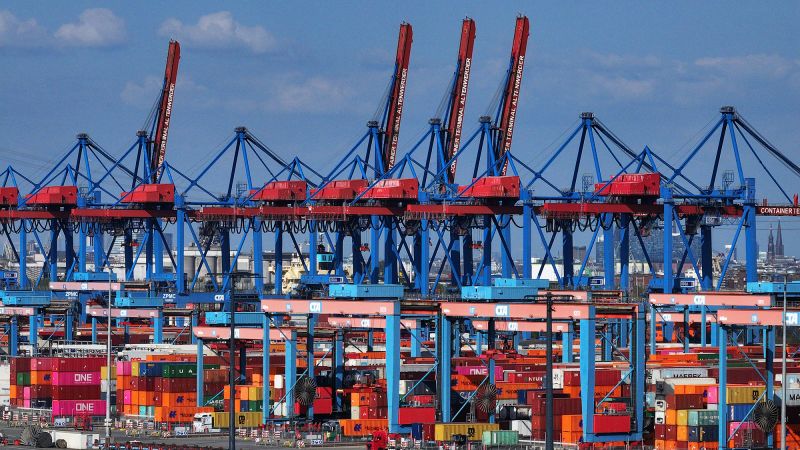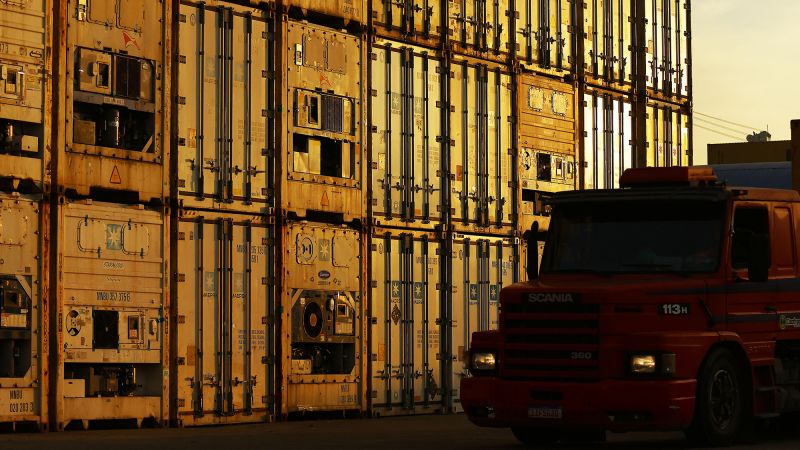US-India Trade Tensions: Who Will Come Out on Top?

Introduction
The relationship between the United States and India is a complex one, with both countries being major players on the global stage. However, recent trade tensions between the two nations have brought their relationship to the forefront of discussions. President Trump's approach to trade negotiations often involves imposing tariffs, but his tactics may not work with India, as they are not showing signs of backing down. It seems that Washington may be misunderstanding India's calm and collected response as a sign of weakness, when in reality, it could be a strategic move.
Key Details
While the U.S. has been imposing tariffs on countries like China, India has not been a major target. However, the U.S. recently removed India from its Generalized System of Preferences program, which allowed India to export certain goods to the U.S. duty-free. In response, India has announced retaliatory tariffs on 28 American products, including almonds, apples, and walnuts. While this response may seem minimal, it is a strategic move by India to protect its domestic farmers and industries, and it shows that India is not afraid to stand its ground against the U.S.
Impact
The U.S. may be underestimating India's strength and determination in this trade dispute. While the U.S. may have more leverage due to its larger economy, India is not backing down and is willing to
About the People Mentioned
Donald Trump
Donald John Trump, born June 14, 1946, in Queens, New York, is an American businessman, media personality, and politician. He graduated from the University of Pennsylvania’s Wharton School in 1968 with a degree in economics. In 1971, he took over his family’s real estate business, renaming it the Trump Organization, through which he expanded into building and managing skyscrapers, hotels, casinos, and golf courses. Trump gained widespread fame as the host of the reality TV show *The Apprentice* from 2004 to 2015, which helped establish his public persona as a successful entrepreneur. Trump entered politics as a Republican and was elected the 45th president of the United States, serving from 2017 to 2021. His presidency was marked by significant policy actions including tax cuts, deregulation, the appointment of three Supreme Court justices, renegotiation of trade agreements (notably replacing NAFTA with the USMCA), and a focus on immigration control including border wall expansion. He withdrew the U.S. from international agreements such as the Paris Climate Accord and the Iran nuclear deal, and engaged in a trade war with China. His administration’s response to the COVID-19 pandemic was criticized for downplaying the virus’s severity. Trump was impeached twice by the House of Representatives—first in 2019 for abuse of power and obstruction, and again in 2021 for incitement of insurrection—but was acquitted by the Senate both times. After losing the 2020 election to Joe Biden, Trump challenged the results, culminating in the January 6, 2021, Capitol riot. He remains a central figure in American politics, having won the 2024 presidential election and returned as the 47th president in 2025, continuing to promote policies aimed at economic growth, border security, and military strength[1][2][3][4].
About the Organizations Mentioned
United States
The **United States** is a federal republic and a global superpower, playing a leading role in economics, military strength, technology, and governance. It is a nation of approximately 348 million people as of 2025, characterized by its diverse population and dynamic economy[8][6]. Founded in 1776 following independence from British rule, the U.S. rapidly evolved into a major world power, especially after World War II, when its technological and economic investments solidified its global dominance[4]. Today, it remains the world’s preeminent military power, with 76% of Americans recognizing this status, while about half view it as the leading economic power globally, though China is seen as a rising competitor[2][3]. The U.S. government operates through a complex system that manages federal finances, taxation, social welfare programs, and trade policies. Recent legislative changes, such as the 2017 Tax Cuts and Jobs Act and the 2025 One Big Beautiful Bill Act, have shaped the tax landscape to influence economic growth, labor markets, and federal revenue[1]. Despite challenges like rising federal deficits projected to reach 6.9% of GDP by 2027, consumer spending remains resilient, and business investment is expected to grow steadily in 2025[5]. In governance, the U.S. is rated "Free" with a score of 84/100 by Freedom House, though concerns about democratic erosion and partisan conflicts persist[6]. Public trust and satisfaction with government services fluctuate, reflecting ongoing debates about policy effectiveness and institutional competence[7]. Technologically, the U.S. maintains a critical edge, underpinning its economic and geopolitical power. Experts warn, however, that technological dominance is not guaranteed indefinitely, emphasizing the need for adaptive policies and international cooperation to sustain leadership in innovation and global affairs[4]. Overall, the United States remains a pivotal force in global business, technology, and politics, balancing historic strengths with contemporary challenges in
India
India, officially the Republic of India, is the world's most populous democracy and the fifth-largest economy with a GDP of approximately $4.2 trillion as of 2025. It is a major global player in business and technology, boasting a robust and diverse economy that grew at about 6.5-7.8% in recent fiscal years, making it the fastest-growing major economy worldwide[1][2][4]. Historically, India has a rich cultural and civilizational heritage dating back over 9,000 years, with early urbanization in the Indus Valley Civilization and the development of significant religious and social systems such as Hinduism, Buddhism, and Jainism. Since gaining independence in 1947, it has evolved into a vibrant democracy with a complex socio-economic structure[3]. Economically, India has transitioned from a primarily agrarian society to a mixed economy with strong service, industrial, and agricultural sectors. The services sector, especially software and business services exports, has been a key driver of economic expansion[1]. Government initiatives like Production-Linked Incentive (PLI) schemes and trade reforms aim to boost manufacturing and exports, targeting $1 trillion in merchandise exports by 2030. Micro, Small, and Medium Enterprises (MSMEs) form a critical component of India's economy, contributing significantly to GDP, employment, and exports, with ongoing efforts to improve their productivity through digital adoption and infrastructure investment[2]. India's current status is marked by a growing middle class, technological innovation hubs (notably in IT and software services), and a strategic push toward green and inclusive development supported by international partnerships such as with the World Bank[1]. The country faces challenges such as income inequality, internet freedom concerns, and political complexities but maintains a favorable global view in many nations due to its economic potential and democratic framework[6][7]. In summary, India represents a dynamic and rapidly evolving organization-state that combines ancient cultural roots with modern economic ambition
Generalized System of Preferences
The **Generalized System of Preferences (GSP)** is a preferential trade program designed to promote economic growth in developing countries by providing reduced or duty-free tariffs on various products exported to developed countries. Unlike the "most favored nation" (MFN) principle, which mandates equal tariff treatment among World Trade Organization (WTO) members, GSP allows developed countries to apply differential tariff reductions favoring developing and least-developed countries to boost their integration into global trade[1][2]. The concept of GSP originated in the 1960s amid discussions at the United Nations Conference on Trade and Development (UNCTAD), where developing countries sought special tariff preferences to accelerate their economic development. The General Agreement on Tariffs and Trade (GATT) formalized this in 1971 by granting temporary waivers to MFN obligations, which became permanent with the 1979 "enabling clause," allowing nonreciprocal, non-discriminatory preferences to developing countries under GSP programs[1]. Major developed economies, including the European Union and the United States, administer their own GSP schemes within the WTO framework. The EU's GSP is notable for its comprehensive structure, offering three tiers: the Standard GSP for low- and middle-income countries; GSP+ for countries committed to sustainable development and human rights conventions; and the Everything But Arms (EBA) arrangement providing duty-free access for least-developed countries except for arms[3]. The U.S. GSP similarly offers duty-free entry for eligible products from developing countries, aiming to foster industrialization, job creation, and poverty alleviation[4][5][6]. Key achievements of GSP include increased export opportunities for beneficiary countries, fostering economic diversification, and supporting sustainable development goals. However, challenges persist, such as limited impact in some regions, eligibility restrictions, administrative complexity, and concerns about competition from beneficiary goods in developed markets[2]. Currently, GSP remains a vital instrument for trade-driven development, evolvin
World Trade Organization
## Overview The World Trade Organization (WTO) is the primary international body dedicated to regulating and facilitating global trade. Established in 1995, it succeeded the General Agreement on Tariffs and Trade (GATT), which had governed trade since 1948. The WTO’s core mission is to ensure trade flows as smoothly, predictably, and freely as possible by providing a framework for negotiating trade agreements, settling disputes, and monitoring national trade policies[3]. Its headquarters are in Geneva, Switzerland. ## What the WTO Does The WTO operates through a set of rules negotiated and agreed upon by its 164 member countries. These rules cover goods, services, and intellectual property, aiming to reduce trade barriers such as tariffs, quotas, and subsidies. The organization also provides a platform for governments to negotiate trade deals and resolve disputes through a structured legal process, helping to prevent trade wars and maintain stability in the global economy[3]. Importantly, despite recent tensions, about 72% of global goods trade still operates under core WTO “most favored nation” tariff terms, underscoring the organization’s ongoing relevance[1]. ## History and Key Achievements The WTO was founded to create a more robust and enforceable system than GATT, which lacked a formal institutional structure. One of its landmark achievements is the creation of a binding dispute settlement mechanism, which has resolved hundreds of trade conflicts since 1995. The WTO has also overseen major trade liberalization rounds, such as the Uruguay Round (1986–1994), which expanded the scope of global trade rules to include services and intellectual property. ## Current Status and Challenges Today, the WTO faces significant challenges. Global merchandise trade is expected to decline slightly in 2025, partly due to rising protectionism and unilateral tariff actions by major economies[2]. The United States, under President Trump, has imposed across-the-board tariffs in 2025, heightening trade frictions and complicating multilateral cooperation within the organization







